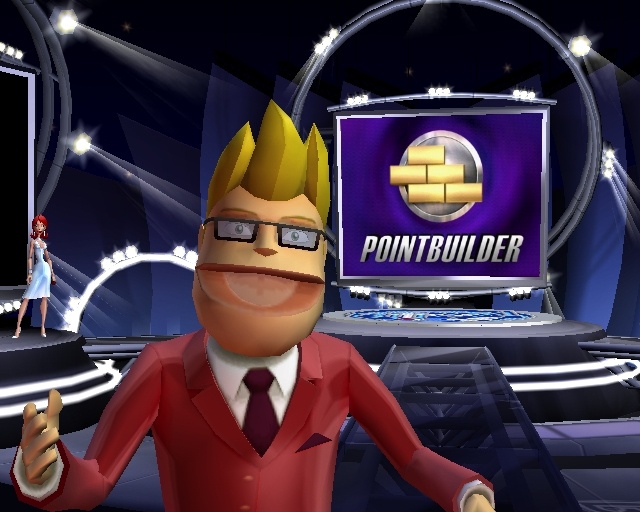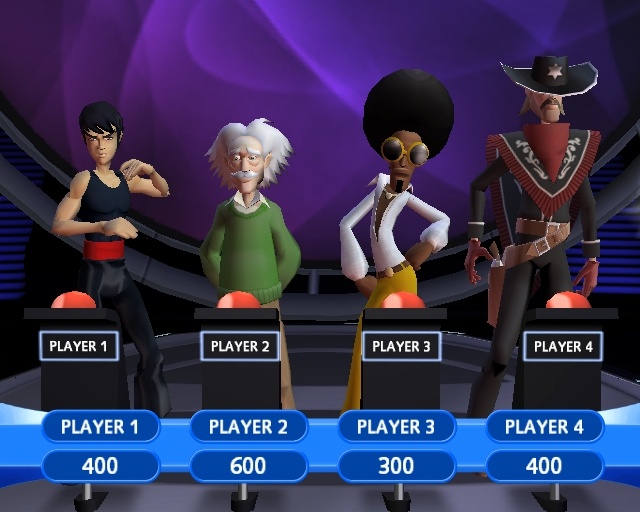Buzz is another Sony game to use a special peripheral, and another game clearly aimed at the mass market. The game is presented in the style of a television quiz show, complete with a cheesy host and a glamorous assistant. But the big attraction of Buzz is the way you interact with it, via the flashing red buzzer. This novel, incredibly simplistic controller will be familiar to anyone who's ever watched a gameshow, and it will attract gamers and nongamers alike. Unfortunately, the quizzes themselves aren't nearly as appealing as they could be, thanks to an overly simplistic difficulty and a few gameplay irritations.

The presentation of Buzz is rudimentary, but it has an appeal that's rooted in the fact that it's based on every TV gameshow ever made. The show itself is called Buzz, and it's presented by a simple but well-animated host called, er...Buzz. Voiced by one-time Australian soap star turned student union-bothering entertainer Jason Donovan, Buzz orchestrates the show with a brash arrogance that makes him engaging for the first few games, but gradually more irritating as novelty turns into repetition.
The BIG Quiz isn't the first game in the series. It follows last year's music quiz by changing the focus from pop to general knowledge. Whereas most of the questions in The Music Quiz were based on audio samples, most of the questions in The BIG Quiz are picture-based, with occasional audio interludes. While the transition works visually, famous figures and geographical locations dominate the selection, with occasional interludes for science and nature. The result is that The BIG Quiz feels like it has been tailored to those looking for lightweight fun as opposed to a cerebral challenge. It's also clear that the questions have been written around the images rather than the other way round, as you'll see figures such as Ron Howard, Orlando Bloom, and Ian McKellen popping up in almost every game.
The controllers included in the package are simply irresistible, and their novelty just about carries the game. You get four buzzers with the game, although if you got the same controllers with The Music Quiz, The BIG Quiz is available separately at a budget price. These four handsets are tied together and plug into one of the PlayStation 2's USB ports, and one of the new features for The BIG Quiz is that two sets can be plugged in for up to eight players. While this makes for a potential nightmare of tangled cables, you'll be hard pressed to find such an all-inviting party game unless you're in possession of two multitaps and a decent sports game. The four coloured buttons on the fascia are used to answer questions, while certain rounds will ask you to buzz in using the flashing red button on top. It's so simple that you don't even need to listen to the instructions for the most part, as the interface will be familiar to anyone who's ever seen a TV gameshow.
A standard game of Buzz!: The BIG Quiz consists of six rounds that last around 15 minutes. The rules for each round vary, but the general goal is to answer each question correctly in the quickest time possible. The format allows you to build points up through the first few rounds and then the later rounds punish you for wrong answers, while allowing you to steal points from your opponents. The most exciting round is pass the bomb, which involves answering questions and desperately trying to get rid of the bomb before it explodes and takes points off your score.
Unfortunately, question repetition can start occurring after you've played a few games, so other play modes are a necessity to maintain interest. The main Play Game screen contains two more subgames, which include a custom game and a single-player game. The custom mode allows you to choose rounds from a selection of eight, dropping the ones you dislike and keeping your favourites. The single-player game features two rounds, both of which are against the clock as opposed to against artificial intelligence characters. The first round awards more points the quicker you answer, and the second is a Weakest Link-style round where you earn more points the longer your run of correct answers. There's also a selection of party games, with Hitman, Quickfire Quiz, and Eliminator minigames. Hitman and Eliminator are big cheats because they are merely the hitman and pass the bomb rounds from the main game. Quickfire Quiz lets you choose from 10 to 100 questions, with the quickest answers earning the most points. Any party guests would be better off playing the main game.
The extras menu has two further options: quizmaster or teamplay. Quizmaster is a strange mode because user interaction with the game is extremely limited. The quizmaster controls the pace using the standard PS2 controller and asks the questions to the contestants verbally. The players buzz in if they know the answer, and the quizmaster tells the game whether they got the answer right by pressing X or triangle. Therefore, the only point of the game is to time the contestants and keep tally of the score. The teamplay option is better; each group has three lives, and answering each question correctly saves these lives. The team that wins is the one left with anything intact at the end of the game.
While the game is well presented on the whole, there are some infuriating bugs that should have been ironed out. The first is a simple change--you should be allowed to quit a game once it's under way, and the fact that you can't is a major annoyance. The second will infuriate people who like gameshows from an educational standpoint. Inexplicably, the game does not reveal the answers to its picture-based questions in word form, so if you get an answer wrong, you're no better informed by the game. An example of this is during the snap round, with the question "Who made his film debut at the tender age of 18 months?" The picture of Ron Howard is shown as the right answer at end of the question, but his name is nowhere to be seen. So if you've no idea what Ron Howard looks like, you'll probably never know the answer to the question.

There are also some improvements that could have been made to the features, some of which simply needed to be reintroduced from the last game. The 15-minute game length feels both a little too long for a quick pre-pub blast and too short for a post-pub grudge match. In The Music Quiz, it was possible to decide on the length of the game from short, medium, and long, whereas that option has been omitted in The BIG Quiz. The Music Quiz also allowed you to tailor the question subjects from a choice of old music and new music. Given the number of questions in the entertainment and geography categories of The BIG Quiz, it would be great if you could narrow the topics in the same way here.
While the general-knowledge focus of the second Buzz game would seem an ideal fit for the gameshow format, the holes in the formula are more apparent in the game's second iteration. There's no difficulty level to choose from, and as a result, the questions never go beyond being slightly challenging. The picture-based nature of the quiz has also resulted in a preoccupation with entertainment and geography-based topics, so if your preference for quizzes is more Mastermind than Wheel of Fortune you'll probably bore of the challenge. While the Buzz titles are ulikely to ever be more than diverting party games, a return to more focussed subject matter in upcoming versions of the quiz ought to serve the franchise better. And if the developers can include video content and tighten up the features, then Buzz should be able to carry on as a party favourite.